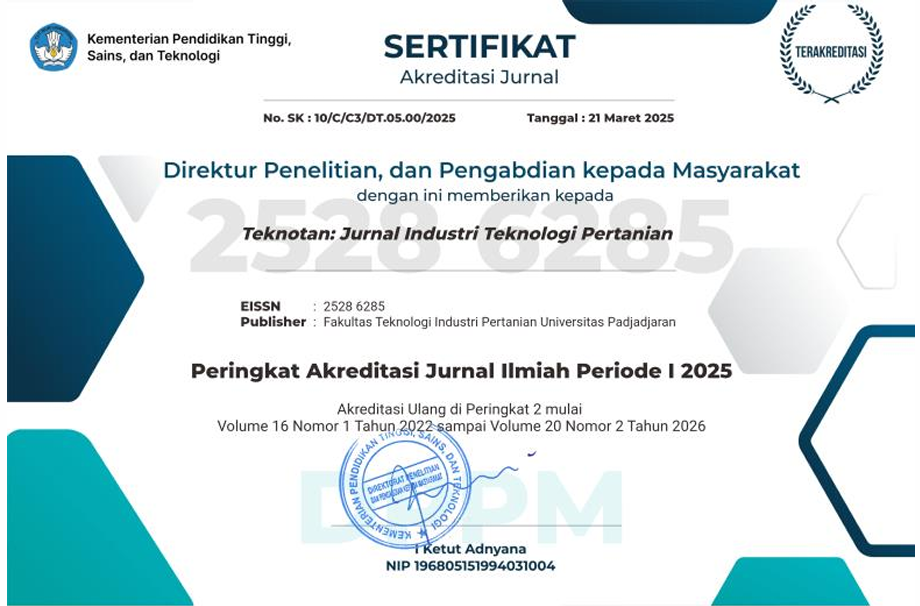Citrus Export Performances of Southeast Asian Countries: A Comparative Analysis
Abstract
Citrus is a popular horticultural commodity worldwide, including in Southeast Asian. This study aimed to comparatively analyze export performances of citrus (limited to lime and lemon) among Southeast Asian countries (ASEAN), that are represented by the top 5 larger exporters, namely Vietnam, Thailand, Indonesia, Malaysia, and Singapore. This study applied several approaches, i.e., RCA (Revealed Comparative Advantage), ECI (Export Competitiveness Index), TSI (Trade Specialization Index), AR (Acceleration Ratio), and EPD (Export Product Dynamics). The secondary data is derived from the International Trade Center from 2010 to 2020. The result showed that those five countries had a low comparative advantage (RCA < 1), but Vietnam had a better performance than other countries. However, Indonesia displayed an upward trend in citrus exports in the last two years (ECI>1). If we look further, Indonesia was still in the initial stage of the citrus export activity to the world market (TSI -0.9), in similar to Singapore and Malaysia, while Vietnam's position was more advanced (TSI 0.9). Indonesia still has a chance to maintain its market share, as indicated by the increased export trend, even though the current condition showed a weak comparative advantage and is still in the initial export stage.
Keywords
Full Text:
PDFReferences
Alexander, I., & Nadapdap, H.J. (2019). Competitiveness analysis of export Indonesia coffee bean in global market 2002-2017 Jurnal Sosial Ekonomi Pertanian. 12 1-16. https://doi.org/10.19184/jsep.v12i2.11271
Arifin, B. (2013). On the competititveness and sustainability of the Indonesian agricultural export commodities. Asean Journal of Economics, Management and Accounting, 1, 81-100.
Ashari, T.D., Setiawan, B., & Syafrial, (2015). Analisis simulasi kebijakan peningkatan ekspor manggis Indonesia. Habitat, 26, 61-70. https://doi.org/10.21776/ub.habitat.2015.026.1.8
Budiarto, R., Poerwanto, R., Santosa, E., Efendi, D., & Agusta, A. (2021a). Sensory evaluation of the quality of kaffir lime (Citrus hystrix DC.) leaves exposed to different postharvest treatments. Journal of Tropical Crop Sciences, 8(2), 71-79. https://doi.org/10.29244/jtcs.8.02.71-79
Budiarto, R., Poerwanto, R., Santosa, E., Efendi, D., & Agusta, A. (2021b). Short communication: Allometric model to estimate bifoliate leaf area and weight of kaffir lime (Citrus hystrix). Biodiversitas, 22(5), 2815-2820. https://doi.org/10.13057/biodiv/d220545
Budiarto, R., Poerwanto, R., Santosa, E., & Efendi, D. (2021c). Morphological evaluation and determination keys of 21 citrus genotypes at seedling stage. Biodiversitas, 22(3), 1570-1579. https://doi.org/10.13057/biodiv/d220364
Budiarto, R., Poerwanto, R., Santosa, E., Efendi, D., & Agusta, A. (2021d). Preliminary study on antioxidant and antibacterial activity of kaffir lime (Citrus hystrix DC) leaf essential oil. Applied Research in Science and Technology, 1(2): 58-65.
Budiarto, R., Poerwanto, R., Santosa, E., Efendi, D., & Agusta, A. (2019a). Agronomical and physiological characters of kaffir lime (Citrus hystrix DC) seedling under artificial shading and pruning. Emirates Journal of Food and Agriculture, 31(3), 222-230. https://doi.org/10.9755/ejfa.2019.v31.i3.1920
Budiarto, R., Poerwanto, R., Santosa, E., & Efendi, D. (2019b). A review of root pruning to regulate citrus growth. Journal of Tropical Crop Sciences, 6(1), 1-7. https://doi.org/10.29244/jtcs.6.01.1-7
Budiarto, R., Poerwanto, R., Santosa, E., Efendi, D., & Agusta, A. (2019c). Production, post-harvest and marketing of kaffir lime (Citrus hystrix DC) in Tulungagung, Indonesia. Journal of Tropical Crop Science, 6(2), 138-143. https://doi.org/10.29244/jtcs.6.02.138-143
Budiarto, R., Poerwanto, R., Santosa, E., & Efendi, D. (2018). Shoot manipulations improve flushing and flowering of mandarin citrus in Indonesia. Journal of Applied Horticulture, 20(2): 112-118. https://doi.org/10.37855/jah.2018.v20i02.20
Budiarto, R., Poerwanto, R., Santosa, E., & Efendi, D. (2017). The potentials of limau (Citrus amblycarpa) as a functional food and ornamental mini tree based on metabolomic and morphological approach. Journal of Tropical Crop Sciences, 4(2): 49-57. https://doi.org/10.29244/jtcs.4.2.49-57
Duong, D.T. (2020). Sustainable development for Vietnam agriculture. E3S Web of Conferences, 175, 1-9. http://doi.org/10.1051/e3sconf/202017501015
Efendi, D., Budiarto, R., Poerwanto, R., Santosa, E., & Agusta, A. (2021). Relationship among agroclimatic variables, soil and leaves nutrient status with the yield and main composition of kaffir lime (Citrus hystrix DC) leaves essential oil. Metabolites, 11(260), 1-14. https://doi.org/10.3390/metabo11050260
Ezterhuizen, D. (2006). An Evaluation of the Competitiveness of the South African Agribusiness Sector. Pretoria: University of Pretoria.
Firmansyah, Widodo, W., Karsinah, & Oktavilia, S. (2017). Export performance and competitiveness of Indonesian food commcodities. JEJAK Journal of Economics and Policy, 10, 289-301. http://doi.org/10.15294/jejak.v10i2.11294
Hanani, N., Hartono, R., & Ratnadi, L.P.A. (2009). Analysis competitivenes level export fruit indonesia. AGRISE. 9 1-9.
Hasanah, S.R. (2020). Mappoing Indonesia’s competitivesness and specialization with its major trading partners. Bappenas Working Paper 3 101-108. https://doi.org/10.47266/bwp.v3i1.59
ITC International Trade Center. (2021). List of exporters for the selected product: product no. 080550. Retrieved from https://www.intracen.org/
Kemendag. (2008). Indeks Spesialisasi Harga. https://www.kemendag.go.id/addon/isp/
Mabberley, D.J. (2004). Citrus (rutaceae): a review of recent advances in etymology, systematics and medical applications. BLUMEA, 49, 481–498. https://doi.org/10.3767/000651904X484432
Moore, G.A. (2001). Oranges and lemons: clues to the taxonomy of Citrus from molecular markers. TRENDS in Genetics, 17, 536-540. https://doi.org/10.1016/s0168-9525(01)02442-8
Nurhayati, E., Hartono, S., & Mulatsih, S. (2019). Analysis of Indonesian nutmeg, mace and cardamoms export development. Jurnal Ekonomi dan Pembangunan Indonesia, 19, 173-190. https://doi.org/10.21002/jepi.v19i2.847
Penniston, K.L., Nakada, S.Y., Holmes, R.P., & Assimos, D.G. (2008) Quantitative assessment of citric acid in lemon juice, lime juice and commercially-available fruit juice products. Journal of Endourology, 22, 567-570. https://doi.org/10.1089/end.2007.0304
Pradipta, A., & Firdaus, M. (2014) Posisi daya saing and faktor-faktor yang mempengaruhi ekspor buah-buahan Indonesia. Journal of Management and Agribusiness, 11, 129-143. https://doi.org/10.17358/jma.11.2.129-143
Putra, H.T., Muhaimin, A.W., & Suhartini, S. (2015). Analysis of the competitiveness of t obacco Indonesia in the international market. Habitat, 6, 57-60. https://doi.org/10.21776/ub.habitat.2015.026.1.7
Rachmi, D.M., Nurmalina, R., & Rifin, A. (2018). Competition analysis of imported and local oranges. Journal of Management & Agribusiness, 15, 1-11. https://doi.org/10.17358/jma.15.1.1
Rosiana, N., Nurmalina, R., Winandi, R., & Rifin, A. (2018). Dynamics of Indonesia robusta coffee competition among major competitor countries. Journal of Industrial and Beverage Crop, 5, 1-10.
Tripoli, E., Guardia, M.L., Giammanco, S., Majo, D.D., & Giammanco, M. (2007). Citrus flavonoids: Molecular structure, biological activity anf nutritional properties: A review. Food Chemistry, 104, 466-479. https://doi.org/10.1016/j.foodchem.2006.11.054
Turner, T., & Burri, B.J., (2013). Potential nutritional benefits of current citrus consumption. Agriculture, 3, 170-187. https://doi.org/10.3390/agriculture3010170
Zuhdi, F., & Suharno, (2015). Competitiveness analysis of Indonesian and Vietnam coffee export in asean 5 market. Habitat, 26, 152-162. https://doi.org/10.21776/ub.habitat.2015.026.3.18
DOI: https://doi.org/10.24198/jt.vol16n1.2
Refbacks
- There are currently no refbacks.
Indexed by:

This work is licensed under a Creative Commons Attribution 4.0 International License (CC BY-SA 4.0)


1.png)
.png)







